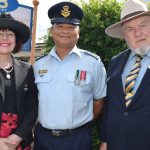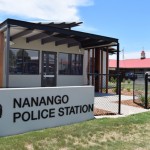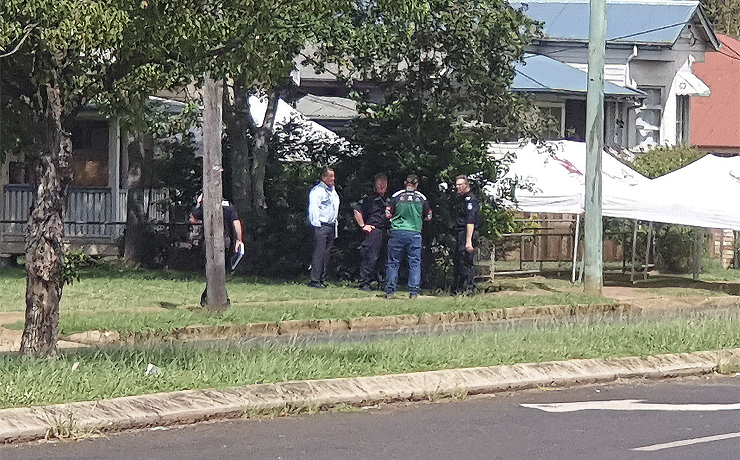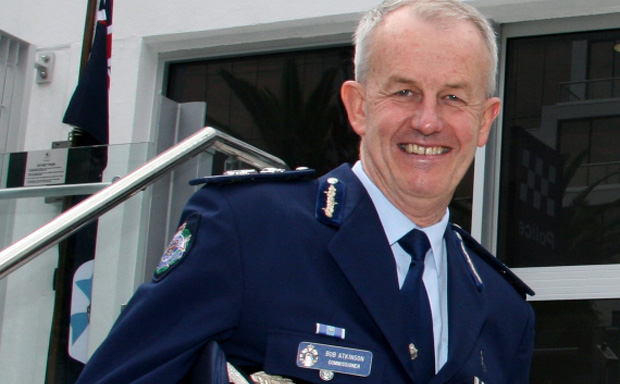
October 29, 2012
Police Commissioner Bob Atkinson was the guest speaker at the recent Kingaroy State High School awards night, and will retire this Wednesday, October 31. We thought our readers may be interested in reading more about his career:
* * *
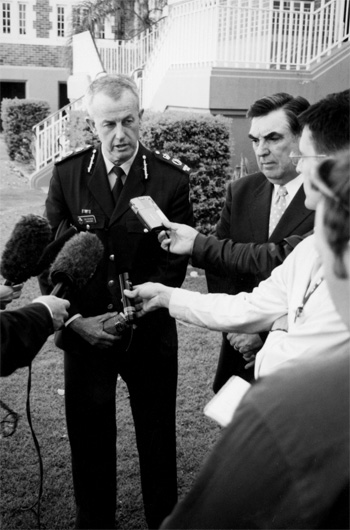
by Paula Hedemann
Queensland Police Service Media & Public Affairs Branch
On July 2, 1968, a 20-year-old Bob Atkinson entered the Petrie Terrace training depot with a new suit and a haircut and an idea that a career as a police officer might be for him.
Forty-four years later, on October 31, 2012, Commissioner Atkinson will leave the Queensland Police Service, having attained the highest possible rank in an organisation barely recognisable from the one he first entered.
Whereas today’s recruits undergo seven months of instruction and a further 12 months of close supervision, the probationer received around three months of military style training—including marching and the polishing of boots—before being sworn in on October 30, 1968. At his first training station at Hemmant, he enjoyed a full three days working with the Officer-in-Charge before being rostered onto his first night shift—alone.
Having inexperienced young people patrolling on their own, armed with only a wooden baton and a pair of handcuffs, was normal in an age where crime was so low, every criminal arrest was published fortnightly in the Police Gazette.
Firearms were not standard issue; an officer could purchase one if they wished but it had to be concealed in an ankle or a shoulder holster. Each officer was also expected to provide their own typewriter.
Despite the challenges, the constable learned quickly and gained confidence, and within a year was convinced he had made the right career choice. It was during his first posting at Sandgate Station from January 1969 to October 1973 that he discovered a passion for investigative work.
Detective appointments were hard to come by however. It was only after a number of applications and nearly five years of trying that he was able to start work as a Plain Clothes Constable with the Criminal Investigation Branch (CIB), based at first in Brisbane, then Fortitude Valley, then back to Sandgate for a further four years.
In 1977, the then-Detective Senior Constable Atkinson successfully applied for a position as Officer-in-Charge of a one-person CIB in Goondiwindi. He recalls fondly both the challenges and rewards of working in a small country town, including the willingness of the local trunk call operators to contribute by offering to pass on confidential messages.
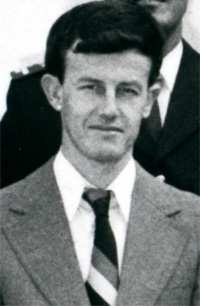
It was during his time in Goondiwindi he came to appreciate that for most people, the most important things are what happens to them and what happens in their own community. He realised police needed to be attuned to that and be appropriately responsive.
After three years he won what he describes as the police lottery, the detective’s posting at Noosa, complete with a house beside the police station which, until 1985, was based at Tewantin. It was a different world from the small country town with stock-related crime. He remained based on the Sunshine Coast for the next decade.
In November 1987, 12-year-old Noosa girl Sian Kingi was abducted and brutally raped and murdered. Detective Sergeant 2/c Atkinson was part of the investigation team that located the suspects and subsequently obtained the confession of Valmae Beck, which resulted in her and husband Barrie Watts being convicted for the horrific crime.
While this case burned itself into the nation’s memory however, it was other events that same year that heralded the coming upheaval that was to shake the foundations of, and ultimately redefine, policing in Queensland.
The Fitzgerald Inquiry commenced in May 1987 and Detective Sergeant Atkinson was to be one of the first witnesses. Sunshine Coast police had successfully shut down an illegal casino after facing earlier obstacles from others in the police force. Commissioner Atkinson credits the “brilliant detective work” of then-Detective Inspector Jim O’Sullivan for exposing illegal activity in the Licensing Branch. A confession by one of the officers under investigation started a domino effect that ended with the Commissioner of Police, Terry Lewis, being sentenced to 14 years in jail for corruption.
Commissioner Atkinson compares the Fitzgerald Inquiry to major surgery — deep, cutting, brutal and painful but necessary — with each day bringing some dreadful new finding.
The inquiry was initially scheduled to go for six weeks, but lasted for over two years, with the final report submitted in July 1989. Widely critical as it was, it presented an incredible opportunity to revitalise the police force, which started with its being renamed the Queensland Police Service in 1990.
The decade that followed saw further inquiries, reviews and change that shaped the Service we know today. That change was profound and included restructuring the organisation, rethinking the criteria for recruiting and promotion, and establishing an external investigative agency to safeguard against future systemic corruption.
Commissioner Atkinson contributed to this metamorphosis, being promoted to the rank of Inspector Grade III in 1990, responsible with a small team for implementing the findings of the Fitzgerald Inquiry in the North Coast Region. In 1992, the then-Inspector transferred to the Professional Standards Unit and soon after was seconded to the Public Sector Management Commission review that provided the current corporate structure of the QPS.
During the term of Commissioner O’Sullivan, Mr Atkinson broadened his skills and experience, becoming Superintendent for the Forensic and Technical Services Branch in 1994, Chief Superintendent for Operations Support Command in 1996, Assistant Commissioner for Far Northern Region in 1997, and then back to Operations Support Command in 1999.
Commissioner Atkinson stepped up to take on the Service’s highest office on November 1, 2000.
The turn of the century brought new fears and hopes, neither of which turned out as predicted. Fears of the ‘Y2K’ bug proved to be unfounded, and the optimism of the new millennium was soon shattered with the terrorist attacks of September 11, 2001, in the USA and, closer to home, the bombing in Bali one year, one month and one day later on October 12, 2002.
In this new atmosphere of fear and insecurity, the Commissioner regards one of the state’s proudest moments as the successful staging of the Commonwealth Heads of Government Meeting at Coolum. Postponed from its original date of October 2001, Queensland became a world leader five months later by hosting the first high-level meeting of international leaders after the September 11 attacks.
Commissioner Atkinson and members of the Senior Executive then set about taking the organisation to what they saw as the next level of policing—defining core business and aligning values and priorities to the community’s expectations.
Ensuring for the safety and security of its people and property was nominated as paramount, as well as providing a professional, ethical and courteous police service, free of entrenched corruption and focussed on working in partnership with the community.
The system of Operational Performance Reviews was introduced as a way of measuring performance in these key areas, with the focus on reducing crime and increasing clear up rates, rather than meeting set targets. The results exceeded understandably cautious expectations in many areas, with car theft, break and enters and armed robbery all dropping significantly over the following 10 years. The road toll was also reduced to 249 — a rate of 5.5 per hundred thousand — in 2010, the lowest total and rate since statistics started to be accurately recorded nearly 60 years earlier in 1952.
While the community will always need the safety, security and support provided by its police service, Commissioner Atkinson also sees an expanded future role for the Service in terms of being community problem solvers. These roles were clearly evident with the Service’s co-ordination of the response to the flood and cyclone disasters of the summer of 2010/2011. He also sees technology as playing a game-changing role in crime prevention and investigation.
When speaking of his time as a police officer, from country to city, constable to commissioner, the word ‘privileged’ is often used.
Overwhelmingly, Commissioner Atkinson has felt it a privilege to serve the people of Queensland, to have visited, lived and worked among the state’s widely diverse communities, to have played a role in some of the defining moments in the history of the Queensland Police Service and to have represented the 15,000 members of the QPS as their Commissioner.
He has earned the respect and indeed, the affection, of those he has worked with over his 44 years as a police officer.
[Photos: Queensland Police Service]







